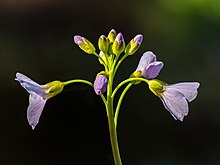|
Cardamine pratensis
Cardamine pratensis, the cuckoo flower, lady's smock, mayflower, or milkmaids, is a flowering plant in the family Brassicaceae. It is a perennial herb native to Eurasia. DescriptionCardamine pratensis is a herbaceous, hairless,[1] perennial plant growing to 60 centimetres (24 in) tall,[2] with pinnate leaves 5–12 cm (2–4+3⁄4 in) long with 3–15 leaflets, each leaflet about 1 cm long. The flowers are produced on a spike 10–30 cm (4–12 in) long, each flower 1–2 cm in diameter with four very pale violet-pink (rarely white) petals.[1][verification needed] The fruit is a seed pod up to 5 cm (2 in).[2] It grows best close to water. EtymologyThe specific name pratensis is Latin for "from/of the meadow". Its common name cuckoo flower derives from the formation of the plant's flowers at around the same time as the arrival each spring of the first cuckoos in the British Isles.[3] An alternative 16th century dated tale refers to 'cuckoo spit', which the plant is sometimes covered in, due to a bug called the froghopper and not the cuckoo.[4] DistributionThe species is widespread in Europe[2] and commonly found throughout the British Isles.[5] Recorded in Ireland from all 40 of the "vice-counties" (a system adopted by Robert Lloyd Praeger in 1901).[6] CultivationIt is grown as an ornamental plant in gardens, and has become naturalised in North America as a result of cultivation. In some European countries, including parts of Germany, the plant is now under threat. It is a food plant for Anthocharis cardamines (the orange-tip butterfly).[citation needed] UsesThe plant is edible with a peppery taste similar to watercress.[2] In cultureIn folklore it was said to be sacred to the fairies, and so was unlucky if brought indoors. It was not included in May Day garlands for the same reason.[7] It is the county flower of the English county of Cheshire.[8] Gallery
References
External linksWikimedia Commons has media related to Cardamine pratensis. |
||||||||||||||||||||||||||||||||









